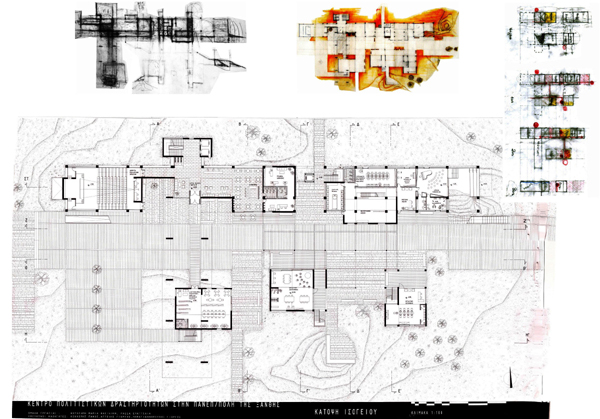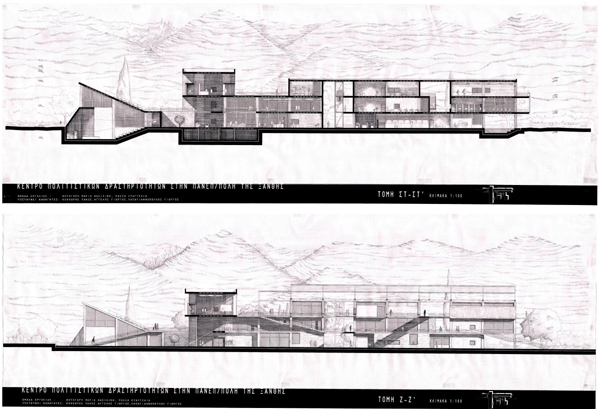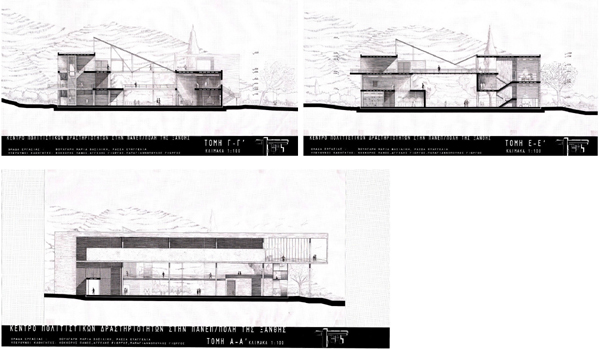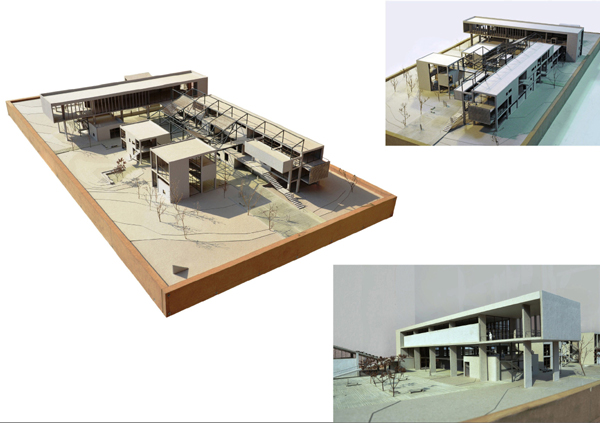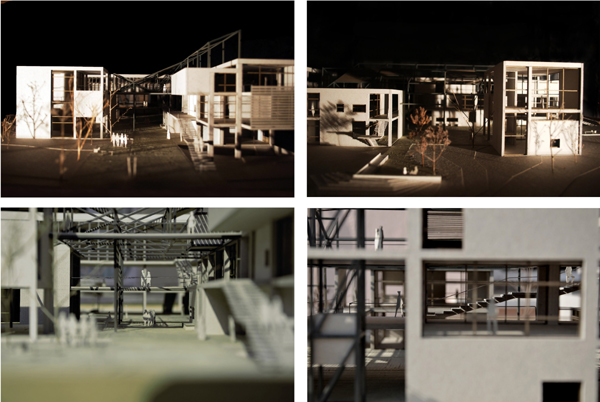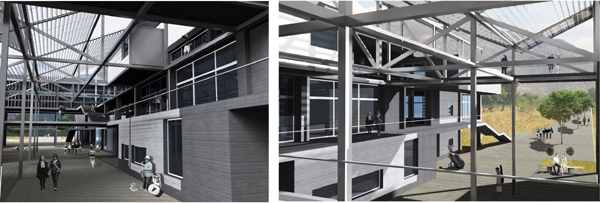STUDENTS PROJECTS
PROJECTS 2011
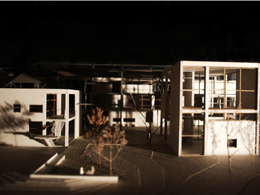
19 March, 2012
Cultural activities centre in the campus of Xanthi
This thesis, basically, deals with substantial issues, pertaining to the University community of Xanthi, which occupied us during our studies in it.
Students : Voulgari Marva, Rassa Valia
Supervisors: Kokkoris Panos, Papagiannopoulos Giorgos, Aggelis Giorgos
Demokritus University of Thrace, School of Engineering, Department of Architectural Engineering
Presentation Date: 15/07/2011
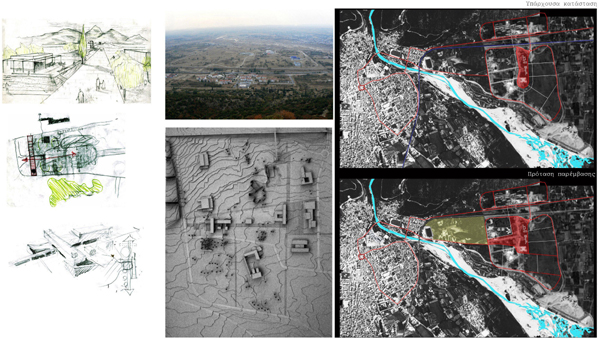
Our daily experience with this place, as well as with the problems and deficits of the University community and the experience of its real needs, resulted an extensive and deep research, aiming to a proposal of intervention to it.
This thesis starts with an analysis of the town plan for the campus of Xanthi, a part of which has already been fulfilled. It is about an introvert plan, which excludes the organic relationship among the departments, as well as the vital interaction with the town, which according to the new spatial plan is about to reach the border of the campus. Simultaneously, it fully ignores the parameters of the landscape, reminding of a plan on "tabula rasa". We would say that it is more about a trace of a road network in a meadow and the split of acres than a plan of a campus, which will project a vision of how a university community must work, as well as its relation and limits with the town where its located.
Having fully analysed all the above mentioned, we have decided to proceed to a mild intervention to the town plan. Originally, we considered as important the creation of a consolidated hard core, that will consist a node and a reference field for the surrounding departments. Due to the possible future growth of the town up to the campus, we have decided to turn this central core towards the town, thus creating a core in the shape of "Γ" capable of undertaking the role of reception, the transition from the town to the campus, the landmark of the students and their channeling to the various departments. Furthermore, this core will consist the connection of the town with the students dwellings near the campus.
With an obvious disposition to enrich this central core with additional functions, so that it attracts more "life" in its interior, more than those that are strictly foreseen for the campus, we wished to intervene to it more specifically. So, we suggest a new type of a building, which will house various labs of creational activities and exhibitions, providing to the students the proper infrastructure and the necessary equipment for their activities. It is an effort to serve a real need, granted that the University, despite its scientific training to the students, should also encourage and support their cultural activities and function as a safeguard of civilization.
After the strengthening of the central core and the entrance of the campus, we thought that the location of the above mentioned building, at the reception area of the campus would be very interesting and useful. Basically, such a building could consist a place where the University community will meet the town and will interact with it, an interactive place. Contrary to the dominating perception of a "closed" scientific community with obvious limits, that isolate it from the life of the town, the University will be open to the city, ready to accept any positive influence from it, and allow mutual activities between the students and the citizens. We would like this building to consist, in an architectural mode, a transition from the town to the campus. Finally, it could also consist a landmark and a symbol for the University community.
BUILDING PROGRAM
The building program resulted by research, granted that no such buildings are anticipated for campuses. So, we searched for samples of other buildings, we studied the needs of every lab that we wanted to include (quantity of classes for the teaching of every lab, the requested square metre per person, equipment of the labs, possibility for outdoor expansion and we defined some minimum sizes for these areas.
The building program includes:
- Receptions- Visitors service (220m²)
- Cafeteria (100m²)
- Multiple use area (320m²)
- Art division for permanent and temporary exhibition (900m²)
- Labs (1090m²)
- Administration offices (80m²)
- Underground storage rooms and engineering installations (180m²)
BASIC SYNTHETIC DECISIONS
- Linear bulk that strengthens the axis towards the square of the campus
- Outflows of the linear bulk that will allow the transverse routes as well as the visual "escape" to the mountain
- Creation of a building-gate that puts limits in the square of the entrance but also strengthens the transition from the square to the outdoor spaces of the building
- Development of the building at both sides of the linear core. Idea of a road, where labs work and expand at both sides of it.
- Overland connections of functions with bridges
- Creation of a shelter which will cover this internal road
- Building-units: they allow the outflow of the routs to the south and perhaps towards the river
- Assurance of organic relation between the labs and the exhibition places- creation of an architectural walk, which will go through the exhibition areas and the labs, providing a total supervision of the building. This architectural walk will head the user from place to place, helping him, through experience to perceive the building and its structure.
- Upward semi-outdoor route: A) it raises gradually the square from the ground level to higher levels of the building. B) it stresses the meaning of the building-gate, which includes spaces of permanent exhibitions, since it consists its ending. C) it consists an important synthetic tool for reading and perception of the building and the relation that it develops with the natural environment.
- Configuration of bulks: A) gate bulk: perhaps the "heaviest" bulk which functions mostly as a gate and also as a screen for the square of the campus entrance. It is not very much related to the life of the rest of the building, it is used for the most formal space of the building, the permanent exhibitions. Therefore, we always try to differentiate it from the rest bulks (different grid, different portions, different approach to facades. B) longitudinal bulk: it is a bulk that interacts with the surrounding environment and is moulded according to it. From one side it tries to pass under the transverse bulk of the gate and make a gesture to the square, while in the other direction it seems to be carved out gradually and from this transversal routes-bridges spring out and they end up in the smaller bulks. C) building-units: they shelter isolated labs which need more the outdoor expansion. They seem to spring out of the building but they remain independent. D) shelter: it shelters the road and stresses the space among the labs and unifies the synthesis.

